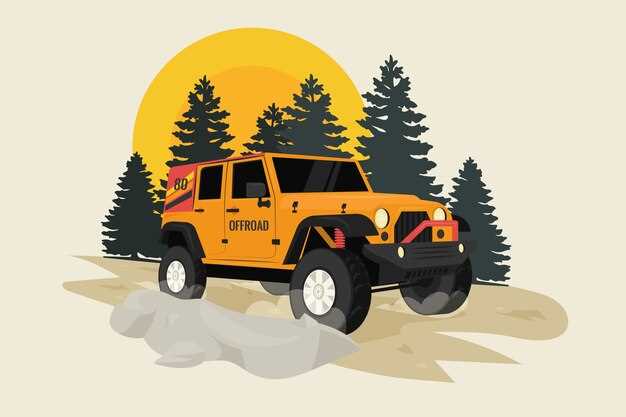For those seeking adrenaline-filled escapades, the right off-road vehicle can transform the wild into a playground. Consider the Jeep Wrangler, renowned for its rugged design and exceptional performance on challenging terrains. With features like solid axles and high ground clearance, it’s built to tackle rocky paths and muddy trails with ease.
The Toyota 4Runner stands out as another great option, combining durability and versatility. Its body-on-frame construction offers stability while navigating through off-road conditions, making it a favorite among adventure enthusiasts. Plus, the off-road capabilities, including multi-terrain select modes, ensure you can conquer any landscape.
If you prefer a compact vehicle without sacrificing power, try the Suzuki Jimny. This mini SUV may be small, but it boasts remarkable off-road capabilities. Its lightweight build and 4WD system allow you to tackle tight spots and steep inclines effortlessly. Perfect for hidden trails and unexpected challenges, the Jimny invites exploration.
For those willing to take on something distinct, the Ford Bronco is back and better than ever. This modern classic offers an array of trims designed for both rugged adventures and daily driving. Its easy-to-remove doors and roof let you experience nature up close, while advanced off-road tech ensures you stay in control during your excursions.
Each vehicle on this list brings unique features tailored to adventure lovers. Choose one that matches your style, gear up, and set out for an exhilarating experience in the great outdoors.
Choosing the Right Off-Road Vehicle for Your Needs
Identify your primary use for the vehicle. If you’re focused on intense trails and rock crawling, consider options like the Jeep Wrangler or Toyota 4Runner. These models feature high ground clearance, robust suspension systems, and excellent four-wheel drive capabilities.
For lighter off-road activities and day-to-day commuting, evaluate crossover SUVs such as the Subaru Outback. It offers sufficient ground clearance and all-wheel drive for less extreme adventures while maintaining comfort and efficiency on paved roads.
Examine the size and passenger capacity. If you plan to travel with family or friends, a larger vehicle like the Ford Bronco can accommodate multiple passengers and gear, making it an excellent choice for group outings.
Assess your budget. Newer models with advanced technology and safety features can be costly. Consider slightly used vehicles like the Land Rover Defender, which balances performance and luxury while being kinder to your wallet.
Check the availability of aftermarket parts and community support. Models like the Toyota Tacoma often have extensive aftermarket support, allowing you to customize your vehicle according to your specific needs.
Test drive your top picks on various terrains. This hands-on experience will give you insight into comfort, handling, and overall performance. Engage with local off-road communities or online forums to gather feedback on your shortlisted vehicles.
Lastly, evaluate the warranty and service options that manufacturers provide. A solid warranty can save you money on repairs and provide peace of mind during your adventures.
Top Features to Look for in Off-Road Vehicles
A sturdy off-road vehicle must have specific features to handle challenging terrains with ease. Here’s a concise guide to the key elements to prioritize:
- Four-Wheel Drive (4WD) System: Choose a vehicle equipped with an advanced 4WD system. Look for features like low-range gearing for superior torque in rough conditions.
- Ground Clearance: Opt for models with high ground clearance, typically 8 inches or more, to prevent underbody damage and ensure better maneuverability over rocks and obstacles.
- Off-Road Tires: Select vehicles that come with durable, all-terrain tires designed to grip slippery surfaces and improve traction. Mud and snow options are a plus.
- Suspension System: Look for a robust suspension system that offers adjustable shock absorbers. This enhances comfort and stability on rugged paths.
- Locking Differentials: Locking differentials distribute power evenly to all wheels, improving traction in uneven or slippery situations.
- Approach and Departure Angles: Check for steep approach and departure angles (preferably over 30 degrees) to ensure safe passage over steep inclines and declines.
- Durable Body Structure: A vehicle with reinforced frames and skid plates provides protection against impacts and prevents damage from rocks and debris.
- Recovery Points: Having designated recovery points is vital for safely towing or being towed in case of getting stuck.
- Onboard Technology: Features like GPS navigation designed for off-road use, as well as modern infotainment systems, enhance the overall experience.
- Fuel Capacity: A vehicle with a larger fuel tank allows for longer adventures without the need for frequent refueling.
Focus on these features to select a vehicle that aligns with your off-road aspirations and tackles the wild with confidence.
Comparative Review of Popular Off-Road Models
The Jeep Wrangler stands out for its rugged build and excellent off-road capabilities. With high ground clearance and advanced 4WD systems, it conquers rocky trails and steep inclines with ease. The interior offers customizable features, making it comfortable for both daily driving and off-road excursions.
The Toyota 4Runner is a reliable choice for adventurers. Its durable body-on-frame construction ensures durability on tough terrains. The 4Runner also boasts impressive towing capacity, which is beneficial for hauling extra gear. With optional KDSS (Kinetic Dynamic Suspension System), it enhances stability during off-road adventures.
The Ford Bronco is a fresh competitor, reviving its classic appeal with modern technology. It features removable doors and roof options, allowing for a more immersive experience. The Bronco Sport variant offers excellent maneuverability with standard all-wheel-drive, catering to both novices and seasoned off-roaders.
The Land Rover Defender combines luxury with off-road prowess. It features a sophisticated Terrain Response system that adapts to different surfaces. Its spacious interior and premium materials elevate the comfort level, making it suitable for both rugged adventures and city driving.
Lastly, the Subaru Outback deserves mention for its all-road capabilities. With standard all-wheel drive and generous ground clearance, it performs admirably on unpaved roads. The Outback offers versatility, balancing daily usability with mild off-road performance, making it ideal for adventurous families.
- Jeep Wrangler: Best for classic ruggedness and customization.
- Toyota 4Runner: Great reliability and towing capacity.
- Ford Bronco: Combines classic features with modern capabilities.
- Land Rover Defender: Luxurious and highly adaptable for various terrains.
- Subaru Outback: Versatile option for mild off-roading and daily use.
Each model brings something unique to the table, catering to different driving styles and adventure preferences. Consider your specific needs and preferences to find the best fit for your off-road lifestyle.
Customizing Your Off-Road Vehicle for Enhanced Performance
Upgrade your suspension system to increase ground clearance and improve ride quality. Consider installing long-travel shock absorbers, which provide better control over rough terrain and enhance stability during descents and climbs.
Install all-terrain tires specifically designed for off-road conditions. Look for tires with deeper treads for better traction in mud, sand, and rocky landscapes. Ensure the tires are compatible with your vehicle’s weight and intended use.
Re-gearing your differential can significantly improve torque and acceleration. If you’ve upgraded to larger tires, adjusting the gear ratio compensates for the change in wheel size, enhancing overall performance.
Enhance your vehicle’s power by adding a performance air intake system. This modification allows for better airflow to the engine, which can boost horsepower and overall efficiency. Pair this with a high-performance exhaust system to maximize the benefits.
Consider weight reduction modifications, such as replacing heavy stock parts with lightweight materials. This could include swapping out bumpers, hoods, and other components with aluminum or fiberglass alternatives, improving agility and fuel efficiency.
| Modification | Benefits |
|---|---|
| Suspension Upgrade | Improved ground clearance and ride stability. |
| All-Terrain Tires | Increased traction in diverse conditions. |
| Re-gearing Differential | Enhanced torque and acceleration. |
| Performance Air Intake | Boosted horsepower and efficiency. |
| Weight Reduction | Greater agility and improved fuel economy. |
Add protective elements like skid plates and differential guards to safeguard your vehicle from obstacles. These additions reduce the risk of damage while tackling challenging trails.
Lastly, tune your engine with an ECU remap for optimized performance. Adjusting the engine control unit settings can enhance throttle response and boost horsepower, ensuring your vehicle meets the demands of rugged terrains.
Maintenance Tips for Longevity in Off-Road Driving
Check your tire pressure regularly. Proper inflation enhances traction and prevents wear. Adjust the pressure based on terrain; lower for sand and mud, higher for rocky paths.
Inspect your suspension system often. Off-road driving can cause wear on shocks and struts. Look for leaks and listen for unusual noises. Address issues before they escalate.
Change engine oil and filters on a strict schedule. Off-road conditions introduce dirt and debris that can contaminate your oil. Clean oil maintains engine performance and extends its life.
Wash your vehicle after each off-road adventure. Remove mud, dirt, and salt to prevent corrosion. Pay special attention to the undercarriage, as it often collects grime that can damage components.
Maintain your battery. Off-road activities can drain batteries quickly. Clean terminals regularly and check connections. Replace the battery every few years to avoid failures during excursions.
Keep an eye on your brake pads and fluid. Off-road driving puts extra strain on brakes. Inspect pads for wear and replace them as needed. Regularly check and top up brake fluid to ensure responsiveness.
Lubricate moving parts, such as hinges and joints, to prevent rust and wear. Use appropriate greases for different components, especially in harsh conditions to maintain flexibility and functionality.
Review your lights and electrical systems. Off-road driving often requires additional lighting. Check all lights for functionality and replace bulbs as needed to enhance visibility during your adventures.
Store your vehicle properly when not in use. Use a cover to protect it from environmental damage. Keeping the vehicle in a dry, cool place can help preserve its components.
Stay proactive with diagnostics. Regular checks can catch issues early. Invest in a diagnostic tool specific to your off-road vehicle to monitor performance and detect potential problems.
Planning Your Off-Road Adventures: Essential Considerations
Identify your vehicle’s capabilities before setting off. Choose a model suited for the terrain you plan to tackle. Research specifications such as ground clearance, approach and departure angles, and four-wheel drive systems. This ensures your vehicle can handle obstacles effectively.
Select the right location tailored to your skills and vehicle type. Look for off-road parks, trails, or natural reserves with varying difficulty levels. Clearly marked routes provide useful guidance for both beginners and more experienced drivers.
Always check weather forecasts ahead of your trip. Rain or snow can transform trails, increasing difficulty and risk. Being prepared for unexpected conditions, such as flash floods or muddy terrains, is crucial for safety.
Pack the right gear. Ensure you have a spare tire, recovery tools, a first aid kit, and sufficient food and water. Equip yourself with communication devices that work in remote areas, such as satellite phones or two-way radios.
Share your itinerary with someone not joining the trip. Keep them informed of your expected return time. This adds another layer of safety in case of emergencies or unexpected situations.
Practice responsible off-roading. Stick to established trails to minimize environmental impact. Avoid driving on fragile ecosystems that may not withstand heavy traffic.
Stay informed about local regulations and guidelines. Some areas may have restrictions on off-roading to protect wildlife or preserve natural habitats. Familiarizing yourself with these rules prevents legal issues and promotes sustainable recreation.
Engage with the off-road community. Online forums and local clubs can provide valuable advice on routes, vehicle modifications, and safety tips. Connecting with experienced off-roaders enhances your knowledge and increases enjoyment.







